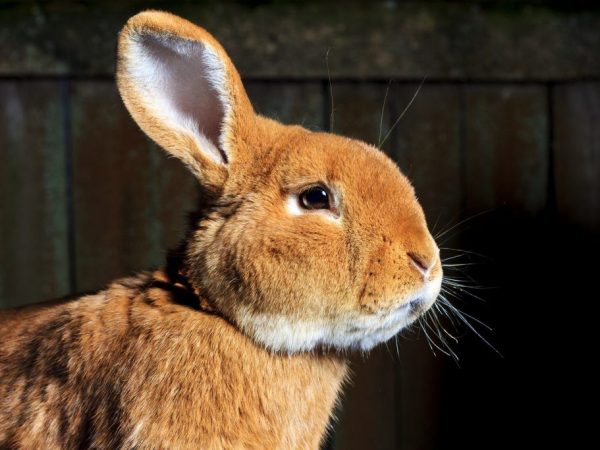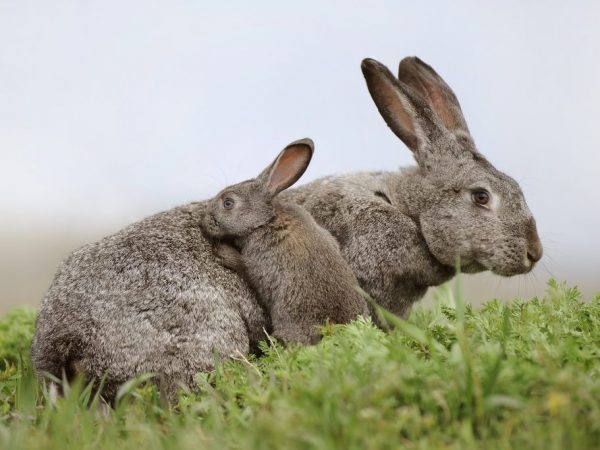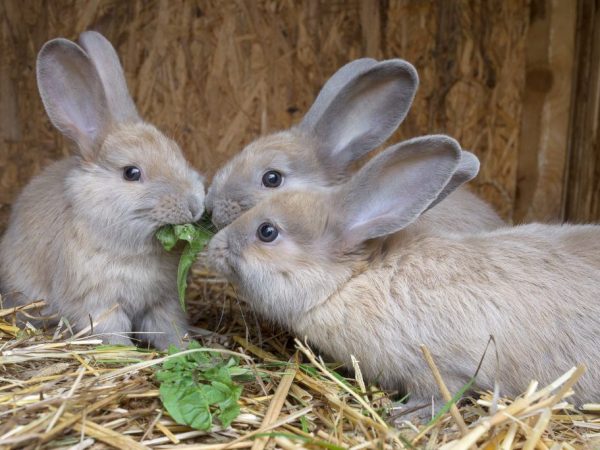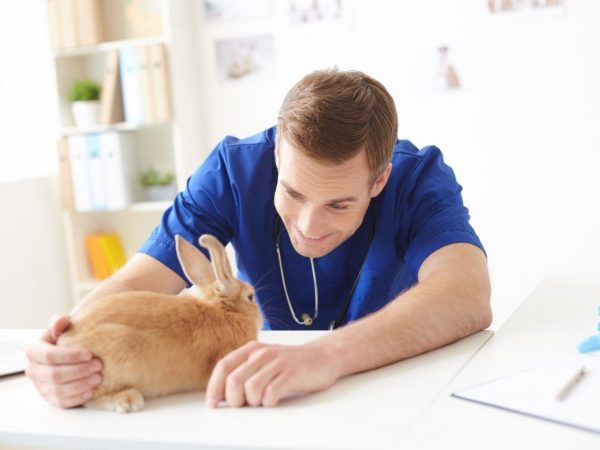How to treat a wet face in rabbits
What is popularly called "biting midge", or "wet face", veterinarians call infectious stomatitis. Little rabbits are especially susceptible to this disease during the period of breastfeeding or weaning from their mother. In a rabbit, wet face disease is transmitted through blood, saliva or urine.

Rabbit wet face
The animal can carry the infection throughout its life. But the activation of the virus occurs due to stress caused by a change in feed, the movement of young animals into separate cells, a change in temperature in the rabbitry.
Symptoms of a wet face in rabbits
A wet face in a rabbit is caused by a filtering virus that enters the body of a healthy animal upon contact with sick relatives.
The spread of the disease in the herd occurs due to errors in the maintenance of recovered individuals. Even if a pet recovers, it remains a carrier of the virus until the end of its life. Such individuals are removed from the breeding divorce and are kept separately from the rest of the herd.
Once in the animal's body, the virus actively multiplies in the cells of the mucous membrane. The symptomatology of the disease progresses rapidly:
- profuse salivation begins;
- the rabbit's nose becomes wet, mucus is released from it;
- the hair on the skin around the nose and mouth is thinning;
- the pet looks disheveled and untidy;
- the mucous membranes of the mouth become bright pink or red;
- weight loss due to decreased appetite;
- 2-3 days after infection, the tongue becomes covered with a white coating, and after that it turns brown;
- in the absence of treatment, plaque is replaced by groups of ulcers;
- then one large ulcer forms at the root of the tongue;
- the skin becomes inflamed;
- wool falls out in places;
- diarrhea begins.
There are many videos on the Internet that show the symptoms of biting midge. You need to know what a sick pet looks like.
Sometimes profuse salivation occurs with mechanical damage to the mucous membrane, burns or poisoning. To start providing timely assistance to the animal, you need to know exactly why the rabbit has a wet face.
Causes of occurrence
A wet face in rabbits can occur for many reasons, but the main one is poor conditions of detention:
- too heaps of animals in a small area;
- dirty cells in which feces are removed in a timely manner;
- contaminated drinkers and feeders;
- the presence of drafts in the rabbitry;
- sudden changes in temperature in the cage;
- decreased immunity;
- poor nutrition.
Recovered animals acquire immunity to the disease, but remain carriers of the virus for their entire life. That is why rabbits develop a wet face if healthy individuals are kept along with those who have been ill.
Infection occurs in another way. Often, female rabbits who have been ill with a biting midge do not have any external signs of the previous illness, but are carriers of the pathogen.If such females are allowed to be divorced, then the resulting offspring can become infected with the disease from the mother.

Reasons for a wet face
For this reason, it is better to buy an adult female from trusted breeders or at livestock shows. The animal must have documents confirming its health and the presence of all vaccinations. Buying males and females from hands in spontaneous markets or from unverified breeders increases the risk of disease affecting the entire livestock.
Forms of infectious stomatitis
The disease of rabbits, in which their muzzle becomes wet, is called infectious stomatitis or biting midge. It has three forms, differing from each other in the severity of symptoms and the presence of complications:
- Lightweight. The appetite of the animal does not suffer much, which is why there is no sharp weight loss and weakness. Stool was normal, no diarrhea The behavior of the young does not change much. Saliva is separated only in the corners of the mouth. Often this form of stomatitis is confused with mechanical damage to the oral mucosa. A wet face in rabbits, if there is treatment, goes away on the 11-14th day. Most pets survive.
- Heavy. All symptoms are extremely strong. The animal completely refuses food and water. The muzzle becomes inflamed and covered with purulent abscesses. The oral cavity is completely covered with ulcers, profuse salivation. Due to severe diarrhea, the animal's body becomes dehydrated. Most often, this form entails the death of the animal 4-5 days from the onset of the disease.
- Atypical. Symptoms are mild or absent. There are no changes in the behavior of the animal. Full recovery occurs 4-6 days after the onset of stomatitis.
Even after recovery, the pet may look sick for several more weeks until the coat returns to normal and the weight regains. Do not rush to transplant a sick pet to relatives.

Rabbit disease form
If the disease is not completely cured, a relapse is possible, that is, the return of the disease and its exacerbation. Only if there is confidence that the pet is completely healthy, can it be released into the general flock.
Treatment of biting midge in rabbits
In order for the animal to survive and recover, treatment of the disease must be started already in the first days after infection, as soon as the first symptoms appear. The livestock breeder chooses how to treat a rabbit, since there are enough funds for this in the modern market of veterinary drugs:
- You can treat the animal with the usual pharmacy Streptocide. The tablets are ground to form a powder and the animal is given orally every 8 hours. The treatment lasts up to 3-4 days.
- The antibiotic Biomycin is used. It is usually used to treat cattle, but if there are no options, then it is better than not treating a rabbit at all. It is important to select the amount of medicine the animal needs, based on its weight. The drug is given once a day for 2 days.
- Penicillin injections have also been shown to work well in young rabbits.
- An effective and inexpensive way to treat a wet chin in a rabbit is Sulfadimezin.
In addition to treating the disease with medications, it is necessary to carry out symptomatic treatment of the disease. This increases the rabbit's chance of recovery:
- With a 15% solution of potassium permanganate, it is necessary to make lotions on the affected areas of the skin of the muzzle.
- 2% of copper sulfate is used to treat the oral cavity of a sick animal. Be very careful to prevent the rabbit from swallowing the solution due to its toxicity.
- Topical application of Streptocide emulsion and Penicillin ointment helps in the rapid healing of ulcers.
- At home, you can make an ointment with your own hands to treat rabbits. To do this, take petroleum jelly, lanolin, sulfamide and 200 thousand dry penicillin. Ointment is applied to the affected skin.

How to treat rabbits
Also, rabbits are prescribed a course of Apidermine to increase immunity and improve tissue regeneration.If the animal is not treated, the disease will worsen and the fluffy will die a painful death.
All drug dosages should be discussed with your veterinarian.
Prevention of viral stomatitis in rabbits
Like any disease, biting midge is better prevented than cured. If an individual with symptoms of viral stomatitis appears in the herd, it is necessary to resort to measures to prevent the epidemic:
- Since the disease does not manifest itself during milk feeding, it is necessary to examine the young every day after leaving the mother, up to 4 months of age.
- When detecting the first signs of a biting midge, all individuals should be isolated. In advance, you need to think about where you can put the rabbits during the quarantine period.
- After the death or slaughter of infected animals, feeders and drinkers should be treated with disinfectants or boiled, if their size allows.
- It is necessary to remove the feces of rabbits in a timely manner, and also to prevent it from being eaten by animals. Due to the deficiency of B vitamins, many animals eat their feces to make up for the deficiency.
- Recovered rabbits are taken out of the breeding divorce. If the eared eared was bought from hands or in dubious nurseries, it is necessary to conduct an analysis for the presence of antibodies in the blood before mating.
Nutrition of rabbits during treatment
Due to damage to the oral cavity during illness, the animal cannot eat and drink normally, which complicates the recovery of the body. The pet should be given soft food:
- boiled root vegetables;
- warm milk with bran soaked in it;
- yogurt;
- liquid porridge.
A full and high-calorie diet during the period of treatment and recovery is the key to a positive outcome of the disease. The transition to a regular diet should be carried out gradually so as not to stress the rabbits.


